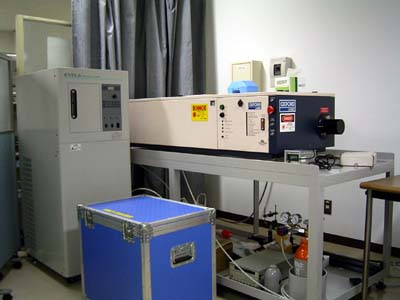|
|
 |
 |
|
 |
|
Supporting Research on the Synthesis of New Organic Molecules and Nano-Materials with Cutting-Edge Analysis Instruments |
 |
|
| |
Ultra High-Speed Camera Device
|
|

Room 5 |
This system is useful to analyze various ultra-high-speed phenomena in nature, such as transfer process of a flash of lightning, destruction process of materials, formation process of turbulent flow, or in more micro-scale level, re-combination of an electron and a positive hole in semiconductors, etc., which are observed in situ visually, thermally, or through photoluminescence processes in the time scale up to of the order of nano seconds. This system consists of two analytical systems, a high-speed camera and video system and a time-resolved photoluminescence spectrophotometer.
High-Speed Camera and Video Systems
1) Ultra-high-speed camera instrumentation: Ultranac standard set ?(Room 5, carrying out is possible)
A photographing speed of 2,000-20,000,000 flame per sec with an exposure time of 10 ns-20 microsecond and an interflame distance of 40 ns-320 micro second is accomplished, and the time resolution is 0.5 ms to 50 ns. The camera lens is of Nikol F mount and the detector is a fluorescence sheet of 80 mm in diameter, which is transferred onto a black and white film of polaroid type.
2) High-speed video instrumentation: Kodak EktaPro HS-4540-2 (Room 5, carrying out is possible)
The maximum photographing speed in the full flame mode with 256x256 image elements is 4,500 flame per sec with a time resolution of 222 micro second, and when used in the divided flame mode with 64 x 64 image elements, the maximum speed is 40,500 flame per sec with a time resolution of 25 micro second. The total number of flames is 3,072, applicable to a phenomenon for 0.68 s, in the full flame mode, and 49,152 for 1.21 s in the divided flame mode. The black and white picture of each flame is recorded on a DRAM memory, which can be transformed and saved in Tiff format. Output type: GP-IB and NTSC. This camera can be used with Image intensifier (3) and Laser system (4) to capture high speed phenomena very clearly.
3) Intensified lens system (ILS): Imco ?(Room 5, carrying out is possible)
This instrument amplifies a very faint light to 100 to 10,000 times, and used with 1 or 2. The diameter of the lens is 40 mm. The gate time can be changed from 10 ns to 1.2 ms by 10 ns step, or to infinity.
4) Ultra-highly bright laser strobe: Copper Vapor Laser illuminator LS2-30 (Oxford Lasers Inc.) ?(Room 5, carrying out is possible*)
This is a very bright light source, which can generate a light beam of 25 mm in diameter and as a 10 kHz sequential pulse of 20-30 ns width at a wavelength of 570.6/578.2 nm. This is used with 1 or 2, and the generation of the light can be matched to the timing of photographing by using an external trigger signal.? This system is also capable of 50 kHz burst mode with external circuits.
* Caution: the laser is very heavy (about 250 kg) and very large (about 150 cm in length).
5) Analytical system for thermal vision image: Nikon Thermal Vision Laird 3ASH? (Room 5, carrying out is possible)
This measures the temperature distribution of materials as a thermal vision image and analyzes. The detector is a PtSi Schottky type Infrared-Charge Coupled Device (IR-CCD), which can detect an electromagnetic wave of a wave length of 3-5 micro meter, and thus the observable temperature range is −20-190/150-500/400-2000 C, and the photographing speed is 60 frame per sec. The total number of image elements is 410,000 (H811 x V508). The type oh lens: F1.2, f 45 mm, where F is inversely proportional to the brightness of the lens and f is the focus distance. The minimum camera distance is 0.5 m. Output type: NTSC, RS232C, and Nikon special digital connector.
|
| 2004.2.9 |
 |
|
 |
|



